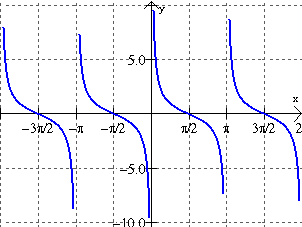the quadrant 11pi/6 is located in
what is quadrant 4?
what is log10(1000)?
what is 3?
Use the graph of h(x) below to determine the intervals where h(x) is increasing and where h(x) is decreasing.
What is A
From the graph, the function decreases until x=−1, then increases between x=−1 and x=1, and decreases again after x=1. This behavior means the function is increasing on the interval (−1,1) and decreasing on the intervals (−∞,−1)∪(1,∞)
Tan X=?
Sin x/ Cos x

This is the degree of the polynomial 4x3-7x+2
What is 3?
Cos(5π/6)
What is -√3/2?
what is logb(xy) rewritten using log rules?
what is logb(x)+logb(y)?
4. Based on the accompanying graph of the polynomial function y = h (x), which statement must be true?
What is C
The graph touches the x-axis at x=−2, indicating a zero of even multiplicity, most likely 2, and crosses the x-axis at x=4, showing a zero of odd multiplicity, likely 1. These behaviors match the description in choice C, making it the correct answer.
Sin2 x + Cos2 x
& = ?
Sec2 x - Tan2 x
1
Describe the end behavior of the polynomial f(x)= -2x4+5x2-1
What is when x approaches negative infinity, y approaches negative infinity?
When x approaches positive infinity, y approaches negative infinity?
The degree of 3π/4
What is 135°?
Solve: log2(x)=5
what is 32?
Given the graph of the function y = f(x) shown below with points a, b, c, d, e, f, g, and h, which of the following pairs of points has the greatest average rate of change?
What is B
The average rate of change is calculated by the formula f(x2)-f(x1)/x2-x1 , which is the slope between two points. From point b to c, the graph shows the steepest upward rise over the shortest horizontal distance, resulting in the greatest positive average rate of change.
Write the Sin Identity for Sin(pi/4 + 5pi/3)
Hint: Use the formula Sin(A+B)= ...
Sin(pi/4) Cos(5pi/3) + Sin(5pi/3) Cos(pi/4)
Find all real zeroes of the polynomial
f(x)= x2-5x+6
What are 2 and 3?
Tan(11π/6)
What is -√3/3?
format 34=81 in logarithmic form
what is log3(81)=9
8. Which of the following is a possible equation for the sinusoidal graph shown below?
What is C
The graph has a vertical shift of +1 (the midline is at y=1) and an amplitude of 2 (oscillating from -1 to 3). Its period is 8, and using the formula Period=2π/B, we solve 2π/B = 8 to get B= π/4. The sine curve is also horizontally shifted, and choice C matches all these characteristics.
Which graph is for f(x)= cot x?
A.

B.

C.
D.
B.

Factor the polynomial f(x)= x3+x2-6x completely.
What is x(x+3)(x-2)?
This is the smallest positive angle in radians greater than π for which the point on the unit circle has a tangent value of 1 and lies in the third quadrant.
What is 5π/4?

solve the e-x^2=e-3x-4
what is x=4 and x=-1
The figure shows the graph of a function f . The zero and extrema for f are labeled, and the point of inflection of the graph of f is labeled. Let A, B, C, D, and E represent the x -coordinates at those points. Of the following, on which interval is f increasing and the graph of f concave down?
(A) the interval from A to B
(B) the interval from B to C
(C) the interval from C to D
(D) the interval from D to E
What is D
From point D to E, the function is increasing (the graph is going upward), and the curve is concave down (it bends downward like an upside-down bowl). This means the slope is positive while the concavity is negative, which satisfies the condition given in the question.
Rewrite K(x)=6/tanx(csc2x−1) using only tan x exactly once and no other trig functions.
P.S: This is straight from the AP exam 🤓
6Tanx
Use synthetic divsion to divide 2x3-3x2+4x-5 by x-2. What is the quotient and remainder
What is the quotiant 2x2+x+6, and the remainder 7